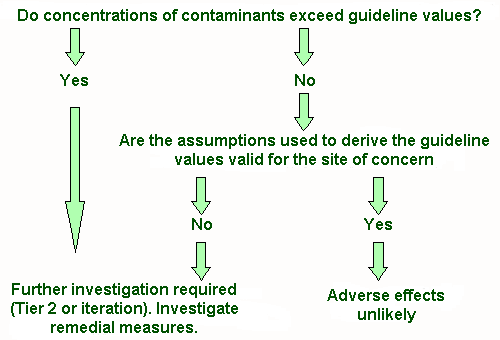|
Limitations of risk assessment Risk Characterisation
|
Risk Characterisation can be defined as 'the process of estimating the magnitude
and probability of effects' (Environment Canada 1994). The objective of Risk
Characterisation is to collate and summarise the information obtained during the previous
tasks. You are essentially attempting to answer the questions
It combines the results of the Receptor Characterisation, Toxicity Assessment and Exposure Assessment to determine the probability that a risk may exist, and if so what the magnitude of that risk is. The purpose of Risk Characterisation is to provide land managers with sufficiently clear information to allow risk management decisions to be made. If the risks are not adequately defined, it may be necessary to proceed with iterations of whichever aspects are lacking or proceed to the next tier of RA. A variety of methods can be used to estimate and characterise the risk. Characterisation of risk can be extremely difficult to achieve, particularly at larger scales of ecological receptors and sites.
Risk Characterisation needs to take into account the limitations of the data collected, and the assumptions and uncertainties inherent in the data and models used. Having characterised the risk, and anticipating the necessity of making a risk management decision, it may also be appropriate to consider the performance in terms of speed and effectiveness of remediation options with regard to the recovery of the affected receptor. It is important to remember that risk characterisation should also take into account the effects of remedial actions on ecological receptors as the adverse effect of mitigation may negate the benefits of removing the contaminant. Tier 1 � Risk characterisation tasksA Tier 1 Risk Characterisation involves comparing the on-site contaminant concentrations with the generic guideline values for the various media (e.g. soil, aquatic) and deciding on the likelihood of an adverse effect being generated. Essentially several simple questions are asked:
In making this assessment you should also consider the quality, the limitations of the data that have been collected, and the appropriateness and assumptions of the guideline values chosen. These criteria are developed to provide very conservative values with margins of safety incorporated. However, if the biota present in/near the site were not considered in the derivation of the criteria, then further investigation may be required. You will also need to critically assess how well the problem has been identified or characterised.
|
![]()
